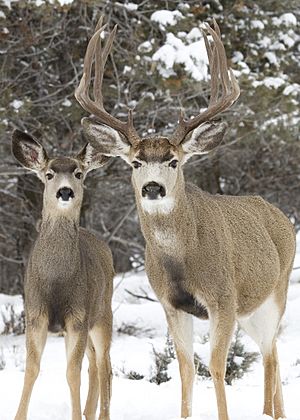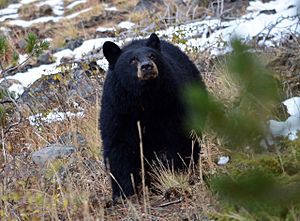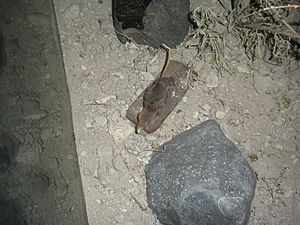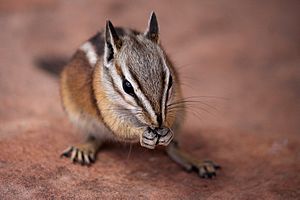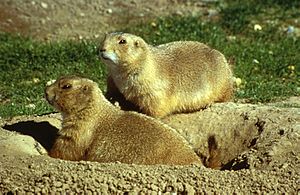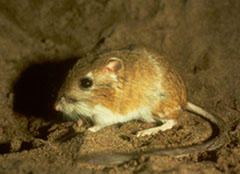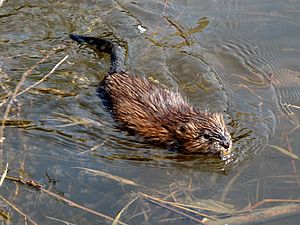List of mammals of Montana facts for kids
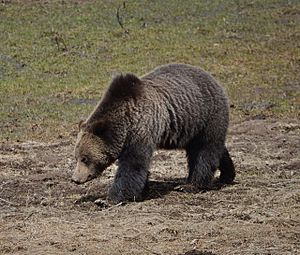
Montana is home to many amazing animals! There are 115 different kinds of mammals living here. Some of these animals are very special. Three of them are listed as either endangered or threatened. This means they are at risk of disappearing forever. The Montana Department of Fish, Wildlife and Parks also keeps an eye on other animals they call species of concern. This article will tell you about some of the cool mammals you can find in Montana.
Contents
Different Kinds of Mammals in Montana
Mammals are animals that have fur or hair, are warm-blooded, and mothers feed their babies milk. In Montana, you can find many different types of mammals, from tiny shrews to huge bison.
Opossums: Unique North American Mammals
Family: Didelphidae (true opossums) Opossums are the only marsupials found in North America. Marsupials are animals that carry their babies in a pouch.
- Virginia opossum, Didelpis virginiana: This opossum was brought to Montana by people. They are known for "playing dead" when they feel scared.
Lagomorphs: Hoppers and Pikas
Family: Leporidae (rabbits and hares) Lagomorphs are known for their strong back legs, which help them hop and run very fast.
- Pygmy rabbit, Brachylagus idahoensis: This is the smallest rabbit in North America.
- Snowshoe hare, Lepus americanus: Its feet get bigger in winter, like snowshoes, to help it walk on snow.
- Black-tailed jackrabbit, Lepus californicus
- White-tailed jackrabbit, Lepus townsendii
- Desert cottontail, Sylvilagus audubonii
- Eastern cottontail, Sylvilagus floridanus
- Mountain cottontail, Sylvilagus nuttallii
Family: Ochotonidae (pikas) Pikas are small, furry animals that look a bit like rabbits but have short, round ears. They live in rocky areas.
- American pika, Ochotona princeps: Pikas collect piles of plants to eat during the winter. These piles are called "haystacks."
Even-Toed Ungulates: Hoofed Mammals
These animals have hooves with an even number of toes. Many of them are grazers, meaning they eat grass and other plants.
Family: Antilocapridae (pronghorns)
- Pronghorn, Antilocapra americana: Often called an antelope, the pronghorn is the fastest land animal in North America.
Family: Bovidae (bovids) This family includes animals with unbranched horns that are never shed.
- American bison, Bison bison: These huge animals once roamed the plains in massive herds.
- Mountain goat, Oreamnos americanus: Mountain goats are amazing climbers, living high up in the mountains.
- Bighorn sheep, Ovis canadensis: Male bighorn sheep have large, curled horns they use when fighting.
Family: Cervidae (deer) Deer are known for their antlers, which males usually grow and shed each year.
- Moose, Alces alces: The largest member of the deer family, moose have huge, flat antlers.
- Elk, Cervus canadensis: Elk are large deer that live in forests and mountains.
- Caribou, Rangifer tarandus: Caribou used to live in Montana but are now rarely seen here.
- Mule deer, Odocoileus hemionus: Named for their large, mule-like ears.
- White-tailed deer, Odocoileus virginianius: They get their name from the white underside of their tail, which they flash when alarmed.
Carnivores: Meat Eaters
Carnivores are animals that primarily eat meat. This group includes many well-known predators.
Family: Ursidae (bears) Bears are large, powerful mammals. They are omnivores, meaning they eat both plants and meat.
- American black bear, Ursus americanus: These bears can be black, brown, or even cinnamon colored.
- Brown bear, Ursus arctos: The grizzly bear is a type of brown bear.
- Grizzly bear, U. a. horribilis: Grizzlies are very strong and are a symbol of Montana's wilderness.
Family: Procyonidae (procyonids)
- Raccoon, Procyon lotor: Raccoons are known for their masked faces and clever paws.
Family: Felidae (cats) Montana is home to several wild cat species, known for their stealth and hunting skills.
- Canada lynx, Lynx canadensis: Lynx have large paws that act like snowshoes, helping them hunt in deep snow.
- Bobcat, Lynx rufus: Bobcats are smaller than lynx and have shorter "bobbed" tails.
- Cougar, Puma concolor: Also called mountain lions, cougars are powerful hunters.
Family: Canidae (canids) This family includes dogs, wolves, and foxes.
- Coyote, Canis latrans: Coyotes are very adaptable and can live in many different habitats.
- Gray wolf, Canis lupus: Wolves are social animals that live and hunt in packs.
- Gray fox, Urocyon cinereoargentus: Gray foxes can climb trees, which is unusual for a fox.
- Swift fox, Vulpes velox: Swift foxes are small and fast, living in open grasslands.
- Red fox, Vulpes vulpes: Red foxes are known for their bushy tails and reddish fur.
Family: Mustelidae (mustelids) Mustelids are often long-bodied and short-legged, known for being fierce predators.
- Wolverine, Gulo gulo: Wolverines are strong and tough, able to survive in harsh, cold environments.
- North American river otter, Lontra canadensis: Otters are playful animals that love to swim and slide.
- Pacific marten, Martes caurina: Martens are agile tree climbers.
- Black-footed ferret, Mustela nigripes: This ferret is one of the most endangered mammals in North America. They were reintroduced to Montana.
- Least weasel, Mustela nivalis: The smallest carnivore in North America.
- American ermine, Mustela richardsonii: Their fur turns white in winter, helping them hide in the snow.
- Long-tailed weasel, Neogale frenata
- American mink, Neogale vison: Minks are semi-aquatic, meaning they live both on land and in water.
- Fisher, Pekania pennanti: Fishers are excellent climbers and hunters.
- American badger, Taxidea taxus: Badgers are powerful diggers, using their claws to find prey underground.
Family: Mephitidae (skunks) Skunks are famous for their strong-smelling spray, which they use to defend themselves.
- Striped skunk, Mephitis mephitis
- Western spotted skunk, Spilogale gracilis
Bats: Flying Mammals
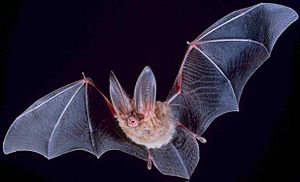
Bats are the only mammals that can truly fly. They use echolocation to find their way and hunt insects in the dark.
Family: Vespertilionidae (vesper bats) This is the largest family of bats, found all over the world.
- Pallid bat, Antrozous pallidus
- Townsend's big-eared bat, Corynorhinus townsendii
- Big brown bat, Eptesicus fuscus
- Spotted bat, Euderma maculatum
- Silver-haired bat, Lasionycteris noctivagans
- Eastern red bat, Lasiurus borealis
- Hoary bat, Lasiurus cinereus
- California myotis, Myotis californicus
- Western small-footed myotis, Myotis ciliolabrum
- Long-eared myotis, Myotis evotis
- Little brown bat, Myotis lucifugus
- Northern myotis, Myotis septentrionalis
- Fringed myotis, Myotis thysanodes
- Long-legged bat, Myotis volans
Shrews: Tiny Mammals with Big Appetites
Shrews are very small, mouse-like mammals with long snouts. They have a very fast metabolism and need to eat almost constantly.
Family: Soricidae
- Northern short-tailed shrew, Blarina brevicauda
- Arizona shrew, Sorex arcticus
- Cinereus shrew, Sorex cinereus
- Hayden's shrew, Sorex haydeni
- American pygmy shrew, Sorex hoyi
- Merriam's shrew, Sorex merriami
- Montane shrew, Sorex monticolus
- Dwarf shrew, Sorex nanus
- American water shrew, Sorex palustris
- Preble's shrew, Sorex preblei
- Vagrant shrew, Sorex vagrans
Rodents: Gnawing Mammals
Rodents are the largest group of mammals. They are known for their continuously growing front teeth, which they keep short by gnawing.
Family: Castoridae (beavers)
- North American beaver, Castor canadensis: Beavers are famous for building dams and lodges in rivers and streams.
Family: Sciuridae (squirrels) This family includes squirrels, chipmunks, marmots, and prairie dogs.
- Golden-mantled ground squirrel, Callospermophilus lateralis
- White-tailed prairie dog, Cynomys leucurus
- Black-tailed prairie dog, Cynomys ludovicianus
- Northern flying squirrel, Glaucomys sabrinus: These squirrels don't truly fly, but glide between trees using a flap of skin.
- Thirteen-lined ground squirrel, Ictidomys tridecemlineatus
- Hoary marmot, Marmota caligata
- Yellow-bellied marmot, Marmota flaviventris
- Yellow-pine chipmunk, Neotamias amoenus
- Least chipmunk, Neotamias minimus
- Red-tailed chipmunk, Neotamias ruficaudus
- Uinta chipmunk, Neotamias umbrinus
- Eastern gray squirrel, Sciurus carolinensis: This squirrel was introduced to Montana.
- Eastern fox squirrel, Sciurus niger
- American red squirrel, Tamiasciurus hudsonicus
- Uinta ground squirrel, Urocitellus armatus
- Columbian ground squirrel, Urocitellus columbianus
- Wyoming ground squirrel, Urocitellus elegans
- Richardson's ground squirrel, Urocitellus richardsonii
Family: Heteromyidae (pocket mice and kangaroo rats) These rodents have external fur-lined cheek pouches for carrying food.
- Hispid pocket mouse, Chaetodipus hispidus
- Ord's kangaroo rat, Dipodomys ordii: Kangaroo rats have very long tails and powerful hind legs for jumping.
- Olive-backed pocket mouse, Perognathus fasciatus
- Great Basin pocket mouse, Perognathus parvus
Family: Geomyidae (pocket gophers) Pocket gophers are burrowing rodents with large cheek pouches.
- Idaho pocket gopher, Thomomys idahoensis
- Northern pocket gopher, Thomomys talpoides
Family: Dipodidae (jumping mice) These mice have long tails and large hind feet, allowing them to jump.
- Meadow jumping mouse, Zapus hudsonius
- Western jumping mouse, Zapus princeps
Family: Cricetidae (New World mice and rats, voles, lemmings, muskrats) This is a very diverse family of rodents.
- Sagebrush vole, Lemmiscus curtatus
- Long-tailed vole, Microtus longicaudus
- Montane vole, Microtus montanus
- Prairie vole, Microtus ochrogaster
- Meadow vole, Microtus pennsylvanicus
- Water vole, Microtus richardsoni
- Southern red-backed vole, Myodes gapperi
- Bushy-tailed woodrat, Neotoma cinerea
- Muskrat, Ondatra zibethicus: Muskrats live in wetlands and are good swimmers.
- Northern grasshopper mouse, Onychomys leucogaster: Unlike most mice, this one eats insects and other small animals.
- White-footed mouse, Peromyscus leucopus
- Western deer mouse, Peromyscus sonoriensis
- Heather vole, Phenacomys intermedius
- Western harvest mouse, Reithrodontomys megalotis
- Northern bog lemming, Synaptomys borealis
Family: Muridae (Old World rats and mice) These species were introduced to Montana by humans.
- House mouse, Mus musculus introduced
- Norway rat, Rattus norvegicus introduced
Family: Echimyidae (spiny rats)
- Nutria, Myocastor coypus: Nutria are large, semi-aquatic rodents that were introduced to North America.
Family: Erethizontidae
- North American porcupine, Erethizon dorsatum: Porcupines are known for their sharp quills, which they use for defense.


